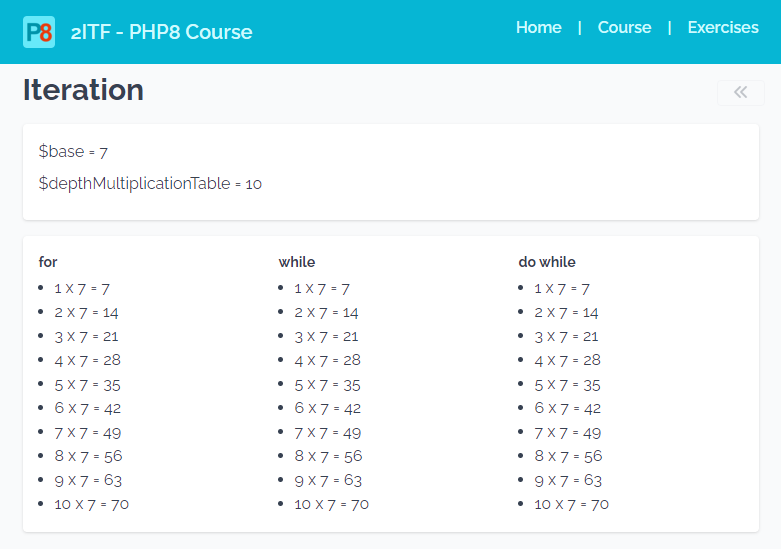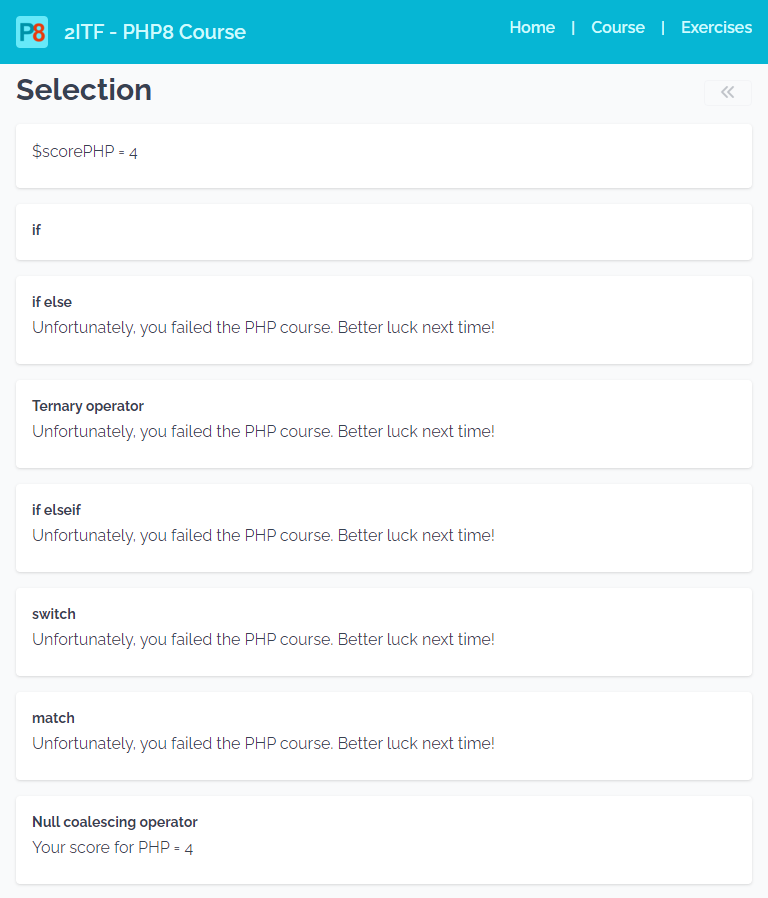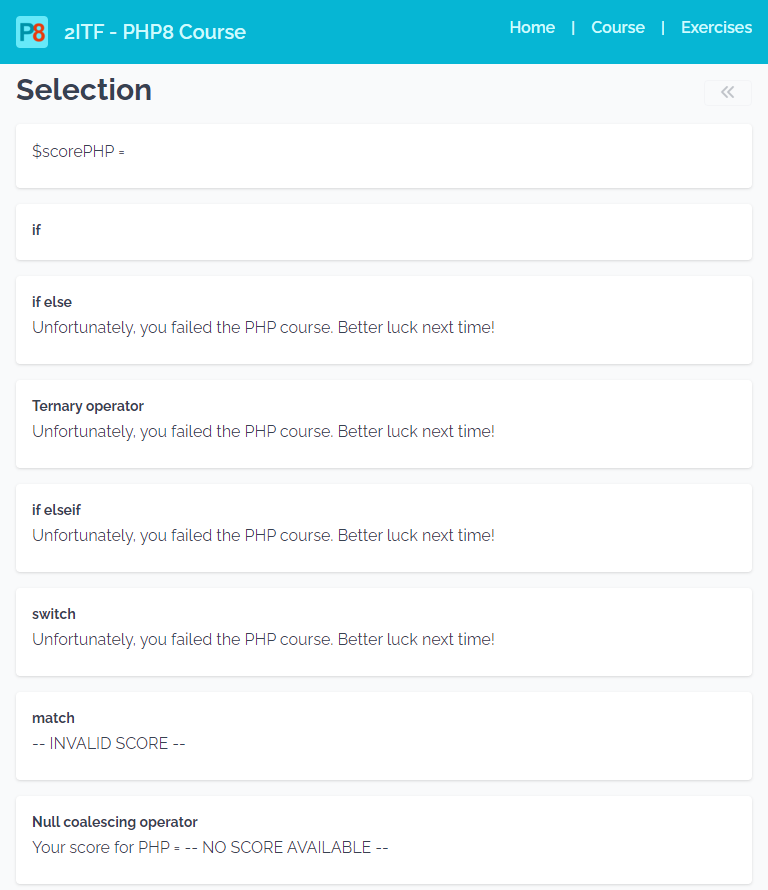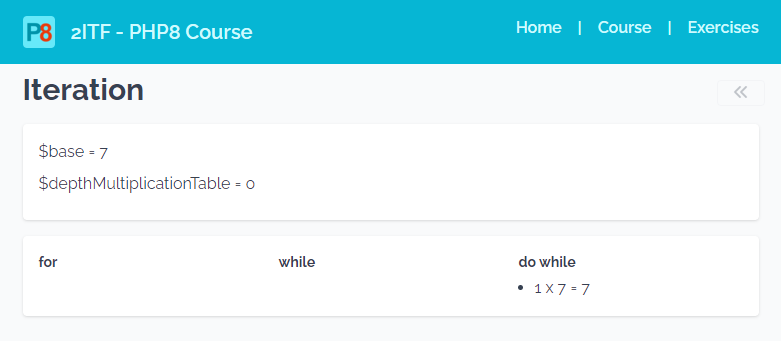# Control structures
# Selection
- In PHP, you can use the following (classical) selection structures
ifif elseif elseifswitchmatch(PHP 8+)
- Open course/selection.php
- Change the value of
$scorePHP(interesting values:4,15,12.7,25.4,null) to see the effect on the different selection structures
- Change the value of
<article> <?php $scorePHP = 9; echo "<p> \$scorePHP = $scorePHP </p>\n"; ?> </article> <article> <h2>if</h2> <?php if ($scorePHP >= 10) { echo "<p> You passed the PHP course. Congratulations! </p>\n"; } ?> </article> <article> <h2>if else</h2> <?php if ($scorePHP >= 10) { echo "<p> You passed the PHP course. Congratulations! </p>\n"; } else { echo "<p> Unfortunately, you failed the PHP course. Better luck next time! </p>\n"; } ?> </article> <article> <h2>Ternary operator</h2> <?php echo $scorePHP >= 10 ? "<p> You passed the PHP course. Congratulations! </p>\n" : "<p> Unfortunately, you failed the PHP course. Better luck next time! </p>\n"; ?> </article> <article> <h2>if elseif</h2> <?php if ($scorePHP >= 10) { echo "<p> You passed the PHP course. Congratulations!</p>\n"; } elseif ($scorePHP >= 8) { echo "<p> You failed the PHP course, but you may tolerate it! </p>\n"; } else { echo "<p> Unfortunately, you failed the PHP course. Better luck next time! </p>\n"; } ?> </article> <article> <h2>switch</h2> <?php switch ($scorePHP) { case 0: case 1: case 2: case 3: case 4: case 5: case 6: case 7: echo "<p> Unfortunately, you failed the PHP course. Better luck next time! </p>\n"; break; case 8: case 9: echo "<p> You failed the PHP course, but you may tolerate it! </p>\n"; break; case 10: case 11: case 12: case 13: case 14: case 15: case 16: case 17: case 18: case 19: case 20: echo "<p> You passed the PHP course. Congratulations!</p>\n"; break; default: echo "<p> -- INVALID SCORE -- </p>\n"; } ?> </article> <article> <h2>match</h2> <?php $result = match ($scorePHP) { 0, 1, 2, 3, 4, 5, 6, 7 => 'Unfortunately, you failed the PHP course. Better luck next time!', 8, 9 => 'You failed the PHP course, but you may tolerate it!', 10, 11, 12, 13, 14, 15, 16, 17, 18, 19, 20 => 'You passed the PHP course. Congratulations!', default => '-- INVALID SCORE --', }; echo "<p> $result </p>\n"; ?> </article> <article> <h2>Null coalescing operator</h2> <?php echo "<p> Your score for PHP = " . ($scorePHP ?? '-- NO SCORE AVAILABLE --') . "</p>\n"; ?> </article>Copied!
1
2
3
4
5
6
7
8
9
10
11
12
13
14
15
16
17
18
19
20
21
22
23
24
25
26
27
28
29
30
31
32
33
34
35
36
37
38
39
40
41
42
43
44
45
46
47
48
49
50
51
52
53
54
55
56
57
58
59
60
61
62
63
64
65
66
67
68
69
70
71
72
73
74
75
76
77
78
79
80
81
82
83
84
85
86
87
88
89
90
91
92
93
94
95
96
97
98
99
100
101
102
103
104
2
3
4
5
6
7
8
9
10
11
12
13
14
15
16
17
18
19
20
21
22
23
24
25
26
27
28
29
30
31
32
33
34
35
36
37
38
39
40
41
42
43
44
45
46
47
48
49
50
51
52
53
54
55
56
57
58
59
60
61
62
63
64
65
66
67
68
69
70
71
72
73
74
75
76
77
78
79
80
81
82
83
84
85
86
87
88
89
90
91
92
93
94
95
96
97
98
99
100
101
102
103
104
$scorePHP = 9
$scorePHP = 4
$scorePHP = 15
$scorePHP = 12.7
$scorePHP = 25.4
$scorePHP = null
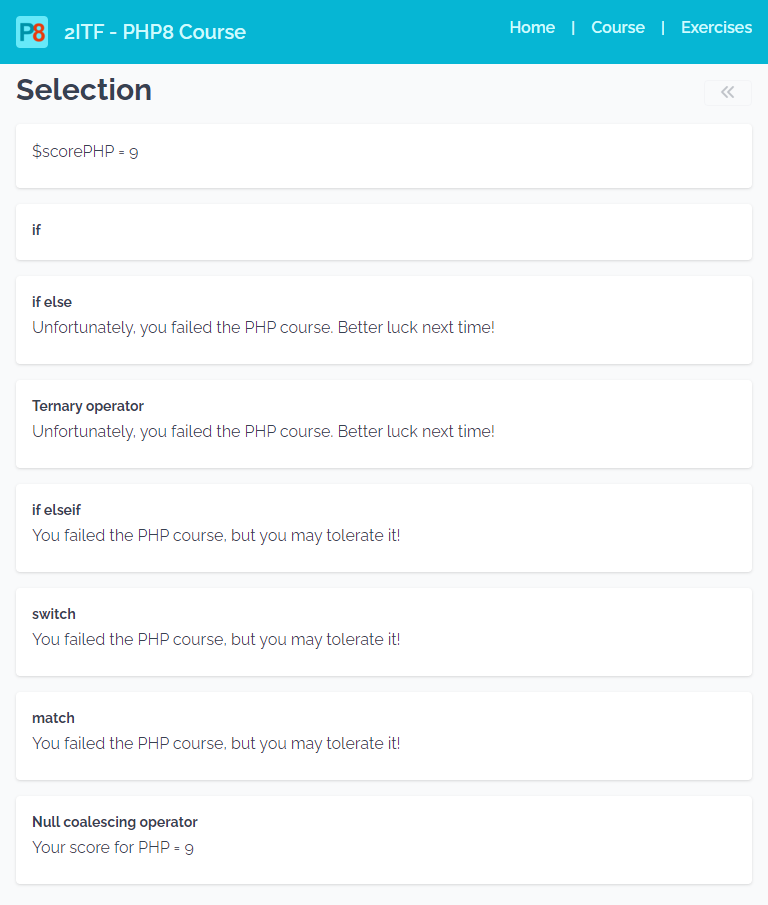
- The match expression is 'almost' similar to a switch statement.
- Unlike switch, it will evaluate to a value much like ternary expressions.
- Unlike switch, the comparison is an identity check (
===) rather than a weak equality check (==)
- The ternary operator
condition ? 'valueTrue' : 'valueFalse'provides a shorthand for anif elsestatement.- If the
conditionevaluates totrue, the result of the operator is'valueTrue'. - Otherwise (
conditionevaluates tofalse), the result of the operator is'valueFalse'.
- If the
- During coding, one often has to check whether a
$variableexists (and is notnull). This can be achieved by the PHPisset()function in combination with a ternary operator:isset($variable) ? $variable : 'fallback'. The null coalescing operator$variable ?? 'fallback'can be used as a shorthand for the latter statement.
# Iteration
- In PHP, you can use the following (classical) iteration structures
forwhiledo while
- Open course/iteration.php
- Change the values of
$baseand/or$depthMultiplicationTable(interesting value:0) to see the effect on the different iteration structures
- Change the values of
<article> <?php $base = 7; $depthMultiplicationTable = 10; echo "<p> \$base = $base </p>\n"; echo "<p> \$depthMultiplicationTable = $depthMultiplicationTable </p>\n" ?> </article> <article class="grid sm:grid-cols-3 gap-4"> <section> <h2>for</h2> <ul> <?php for ($i = 1; $i <= $depthMultiplicationTable; $i++) { echo "<li> $i x $base = " . ($i * $base) . "</li>\n"; } ?> </ul> </section> <section> <h2>while</h2> <ul> <?php $j = 1; while ($j <= $depthMultiplicationTable) { echo "<li> $j x $base = " . ($j * $base) . "</li>\n"; $j++; } ?> </ul> </section> <section> <h2>do while</h2> <ul> <?php $k = 1; do { echo "<li> $k x $base = " . ($k * $base) . "</li>\n"; $k++; } while ($k <= $depthMultiplicationTable); ?> </ul> </section> </article>Copied!
1
2
3
4
5
6
7
8
9
10
11
12
13
14
15
16
17
18
19
20
21
22
23
24
25
26
27
28
29
30
31
32
33
34
35
36
37
38
39
40
41
42
43
44
45
2
3
4
5
6
7
8
9
10
11
12
13
14
15
16
17
18
19
20
21
22
23
24
25
26
27
28
29
30
31
32
33
34
35
36
37
38
39
40
41
42
43
44
45
$depthMultiplicationTable = 10
$depthMultiplicationTable = 0
